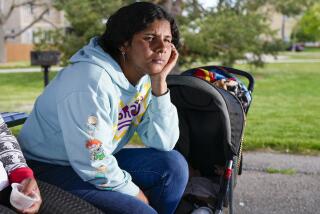TB an Unwelcome Hitchhiker With Immigrants : Medicine: Nurse says highly contagious disease is entering U.S. along with a variety of newcomers.
- Share via
SEATTLE — The patient, a 68-year-old Vietnamese refugee, couldn’t speak English. Dorothy Byas couldn’t speak Vietnamese.
So they traded nods and smiles as Byas handed the man six pills and watched him struggle to swallow them, one by one.
“I can communicate with anybody,” Byas said later, outside the man’s apartment. “As long as I show them warmth and that I’m there to help them, they feel it. So far, I haven’t met anybody I can’t relate to.”
That’s no small feat, given her job at the multicultural front line of the war against tuberculosis, a contagious disease now making a deadly comeback in the United States.
Byas is a tuberculosis outreach nurse, and her patients reflect the changing face of an old disease. During a recent day’s work, all but one of her 14 patients were immigrants--four from Vietnam, three from Cambodia, and one each from Tibet, Laos, the Philippines, Mexico, Ethiopia and Somalia.
Ten years ago, TB was considered a scourge of the past, vanquished in America by modern antibiotics. But now, after decades of decline, it is on the rise, due in part to the growing number of immigrants who carry the disease from countries where it still is common.
Health officials consider it a serious threat. A chronic bacterial infection that usually strikes the lungs and spreads through coughing and sneezing, tuberculosis was the nation’s No. 1 killer in the 1800s. Worldwide, it still kills more people than any other infectious agent.
Last year in the United States, 26,673 cases of active TB were reported, a 20% increase since 1984, according to the federal Centers for Disease Control and Prevention.
Twenty-seven percent of those 1992 cases were among foreign-born patients, the CDC said, and states with large immigrant populations report even higher percentages. In Washington, 46% of all the state’s TB cases last year occurred among immigrants; in California, 61%; in Hawaii, 83%.
*
Immigrants are not the only avenue in TB’s resurgence. The cramped quarters and unsanitary conditions of poverty play a role, and the disease also has become a leading opportunistic infection striking AIDS patients.
In some areas, particularly New York and other Eastern cities, the main worry now is the spread of new multidrug-resistant strains of TB that develop when patients stop taking medicine before it completely kills the infection.
But immigrants present a special challenge, as health officials struggle with language and cultural barriers to find active TB cases and cure them before they spread to the general population.
In California, where illegal immigrants from Mexico have contributed to a statewide 54% rise in tuberculosis since 1985, the state runs an Office of Border Health and conducts TB screenings in migrant labor camps.
In Hawaii, officials inspect chest X-rays of every legal immigrant.
“Because we’re an island, even one case can be catastrophic,” said Dr. Azucena Ignacio, head of Hawaii’s TB control program.
In Washington, an experimental project targets young Hispanic men in jail, screening them for TB and then following up with preventive care once they’re on the streets of Seattle.
Health officials tap the best of modern medical wizardry. In California’s Orange County, DNA fingerprinting recently helped trace a TB outbreak among foreign-born high school students back to a single student.
But more often, the battle hinges on old-fashioned methods such as community outreach, education and screening of high-risk populations.
*
A staple of elimination efforts is directly observed treatment. Knocking out a TB infection requires that a patient take potent antibiotics for at least six months. But symptoms--which may include fever, chest pain and coughing up blood--diminish after a few weeks, and many patients don’t bother to finish their treatment.
That’s where outreach workers like Byas come in, personally delivering packets of pills and making sure they are swallowed.
When she started in 1984, most of her patients were Skid Row drunks, wheezing old men who washed down their pills with swigs of fortified wine.
The foreign-born patients who now predominate present different challenges. By the time Byas deals with them, an interpreter has explained what is going on, but difficulties remain.
Some immigrants, especially Asians and Africans, are leery of the pills Byas offers.
“People will tell us our medicine is nasty, that it’s going to kill them,” she said. “Some of them will wait until I leave and spit their pills right out, so I stay a while and talk to them to make sure they swallow.”
She tells of one Vietnamese woman who insisted on keeping her treatment a secret from her husband, who disapproved of Western medicine.
“She’d hang a blue sock in the window if her husband was home. If I saw that, I would bring in a book and make believe I was selling her something, or I’d read from a newspaper--anything to pass the time. Finally he would leave, and then she would take the pills.”
In Seattle and surrounding King County, one of every four TB patients takes pills under direct observation.
*
Dr. Charles Nolan, head of the county’s tuberculosis program, hopes to reach half of all patients soon. But he and other health officials say the epidemic won’t be arrested until the entire medical establishment wakes up to tuberculosis.
“We’re running as fast as we can with these kinds of services, and we’re still losing ground,” Nolan said. “We think TB screening and prevention ought to be a part of routine health care in high-risk populations--just like childhood immunizations.”
Some critics say improved care for tuberculosis will only increase America’s lure for Third World residents, thereby erasing any gains.
“It’s no surprise, after 30 years of sustained illegal immigration, that we should see the resurgence of diseases we thought were long since conquered,” said Dan Stein, executive director of the Federation for American Immigration Reform.
His group’s proposed solution: Crack down on illegal immigration and reduce legal immigration.
Please excuse Dorothy Byas if she leaves the policy debate to others. She is too busy delivering pills. A decade ago, it was common wisdom that tuberculosis soon would be eliminated in the United States. Now, at age 64, Byas knows the battle will continue long after she retires.
Still, she has reason for hope. Tuberculosis is curable, after all, and her patients, despite cultural differences, share a desire that anyone can understand.
“They really want to get well,” she said.
More to Read
Sign up for Essential California
The most important California stories and recommendations in your inbox every morning.
You may occasionally receive promotional content from the Los Angeles Times.













